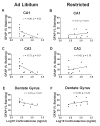Photoperiod interacts with food restriction in performance in the Barnes maze in female California mice
- PMID: 21198981
- PMCID: PMC3059189
- DOI: 10.1111/j.1460-9568.2010.07528.x
Photoperiod interacts with food restriction in performance in the Barnes maze in female California mice
Abstract
Food restriction has been reported to have positive effects on cognition. This study examines how another environmental factor, daylength, can alter the impact of food restriction on the brain and behavior. Female California mice (Peromyscus californicus), housed on either long days (16 h of light and 8 h of darkness) or short days (8 h of light and 16 h of darkness), were restricted to 80% of their normal baseline food intake or provided with food ad libitum. Testing in a Barnes maze revealed that the effects of food restriction depended on photoperiod, and that these effects differed for acquisition vs. reversal learning. During acquisition testing, food restriction increased latency to finding the target hole in short-day mice but not in long-day mice. In reversal testing, food restriction decreased latency to finding the target hole in long-day mice but not in short-day mice. Latency to finding the hole was positively and independently correlated with both errors and time spent freezing, suggesting that changes in both spatial learning and anxiety-like behavior contributed to performance. Short days increased hippocampal expression of the synaptic protein, synapsin I, which was reversed by food restriction. Short days also reduced plasma corticosterone levels, but diet had no effect. There was no effect of diet or photoperiod on hippocampal expression of the glial marker, glial fibrillary acidic protein. The present findings suggest that, in female California mice, the differential effects of food restriction on acquisition and reversal learning are photoperiod-dependent. These results justify further testing of the relationship between food restriction and hippocampal synapsin I in the context of spatial learning.
© 2010 The Authors. European Journal of Neuroscience © 2010 Federation of European Neuroscience Societies and Blackwell Publishing Ltd.
Figures
References
-
- Barnes CA. Memory deficits associated with senescence: a neurophysiological and behavioral study in the rat. J Comp Physiol Psychol. 1979;93:74–104. - PubMed
-
- Beeler JA, Prendergast B, Zhuang XX. Low amplitude entrainment of mice and the impact of circadian phase on behavior tests. Physiology & Behavior. 2006;87:870–880. - PubMed
-
- Boxenbaum H, Neafsey PJ, Fournier DJ. Hormesis, Gompertz functions, and risk assessment. Drug Metab Rev. 1988;19:195–229. - PubMed
-
- Bredy TW, Lee AW, Meaney MJ, Brown RE. Effect of neonatal handling and paternal care on offspring cognitive development in the monogamous California mouse (Peromyscus californicus) Horm Behav. 2004;46:30–38. - PubMed
Publication types
MeSH terms
Substances
Grants and funding
LinkOut - more resources
Full Text Sources









